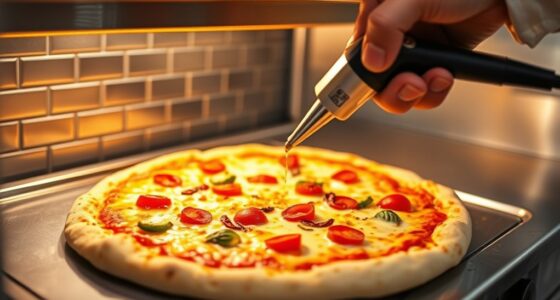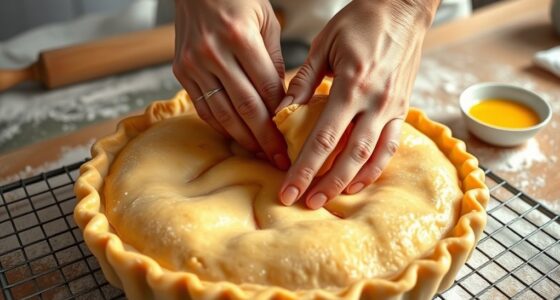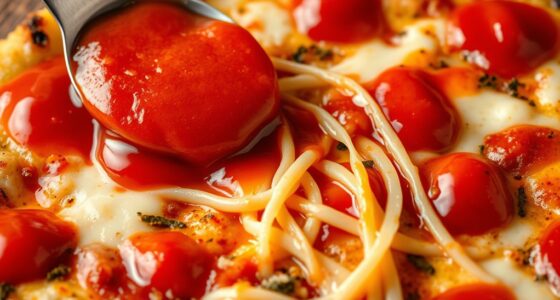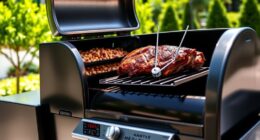Mastering two-zone grilling involves understanding when to use direct or indirect heat to achieve ideal results. Use direct heat for quick searing and creating a crust, while indirect heat is best for longer cooking, smoking, and tenderizing larger cuts without burning. Switching between these methods helps prevent charring and ensures even cooking with rich smoky flavors. If you’re ready to improve your grilling skills, explore how to effectively control both heat zones for perfect outcomes.
Key Takeaways
- Direct heat involves placing food directly over flames, ideal for quick searing and browning.
- Indirect heat uses a cooler zone away from flames, suitable for slow cooking and smoking.
- Mastering two-zone grilling allows precise control over flavor, texture, and doneness.
- Switch between methods to achieve perfect searing with indirect cooking for tender, smoky results.
- Proper setup of heat zones prevents burning, ensures even cooking, and enhances overall grilling success.

When it comes to grilling or cooking over a fire, understanding the difference between direct and indirect heat is vital for achieving the perfect result. Mastering these concepts allows you to control how your food cooks, influencing everything from flavor to texture. One of the key benefits of using indirect heat is the ability to infuse a rich smoke flavor into your meat or vegetables. When you set up your grill with two zones—one hot and one cooler—you can expose your food to the gentle, smoky environment that develops when smoke and heat circulate around the food without direct contact with flames. This method is especially useful for larger cuts that require longer cooking times, as it prevents charring and ensures even doneness. Additionally, understanding cost‑of‑ownership can help you select the right setup for your needs and budget. Temperature control plays a pivotal role here. When using indirect heat, you can maintain a consistent, lower temperature, reducing the risk of burning or drying out your food. This steady heat allows flavors to develop gradually, enhancing the smoke flavor without overpowering the natural taste of your ingredients. By adjusting vents or using a two-zone setup, you can fine-tune the temperature in each zone, giving you more precise control over the cooking process. This flexibility makes indirect heat ideal for slow roasting, smoking, or delicate foods that need a gentle touch. On the other hand, direct heat involves placing your food directly over the flames or hot coals. This method is perfect for searing steaks, burgers, or foods that benefit from quick, high-temperature cooking. With direct heat, you get rapid browning and a satisfying crust, but it requires close attention to prevent burning. Because the heat is intense and localized, controlling the temperature is more challenging, so you need to flip and monitor your food constantly. While it’s less suitable for infusing smoke flavor, direct heat excels at creating that desirable char and caramelization that adds depth to your dishes. Knowing when to switch between direct and indirect heat—and how to set up your grill accordingly—gives you full control over the cooking process. For tender, smoky, and evenly cooked results, indirect heat is your go-to. For quick, high-temperature tasks, direct heat delivers the crisp exterior you crave. Balancing these methods lets you maximize flavor, achieve perfect doneness, and avoid common grilling pitfalls. Ultimately, understanding these two techniques empowers you to create restaurant-quality meals right in your backyard.
Frequently Asked Questions
Which Foods Are Best Suited for Direct Heat Grilling?
You should use direct heat grilling for foods like steaks, burgers, and thin cuts of chicken, which cook quickly and benefit from a nice sear. Before grilling, apply your favorite grill seasoning or marinade tips to enhance flavor. Keep an eye on these foods to prevent burning, and turn them frequently. This method gives you that perfect char while locking in juices, making your grilled favorites irresistibly delicious.
How Do I Control the Temperature for Indirect Heat?
Did you know that using a grill thermometer can improve your temperature control by up to 25%? To manage indirect heat, set up your grill with distinct heat zones, one hot and one cooler. Use the thermometer to monitor the cooler zone, adjusting vents or burners to maintain a steady temperature. This precise control helps you cook foods evenly, especially during slow roasting or smoking.
Can I Use Both Direct and Indirect Heat Simultaneously?
Yes, you can use both direct and indirect heat simultaneously by setting up a dual zone setup on your grill. This allows you to manage heat effectively, searing your food over direct heat while finishing it with indirect heat. To do this, turn on one side of your grill and leave the other side off. This way, you control the temperature and cooking process for different stages of your meal.
What Are Common Mistakes When Using Two-Zone Grilling?
You often make common pitfalls when using two-zone grilling, like not managing heat properly or overcrowding the grill, which can lead to uneven cooking. Safety hazards occur if you neglect to keep a close eye on flare-ups or don’t use tools properly. To avoid these issues, monitor your temperatures carefully, keep a spray bottle nearby for flare-ups, and give each zone enough space to prevent accidents and guarantee your food cooks evenly.
How Do I Clean and Maintain My Grill for Optimal Performance?
To keep your grill performing its best, regularly clean the grates with a grill brush after each use to prevent buildup. Remove ash and debris from the bottom to guarantee proper airflow and heat distribution. Periodically deep clean your grill, including the burners and interior. Proper maintenance extends your grill’s lifespan and improves cooking results, making your two-zone grilling sessions more enjoyable and efficient.
Conclusion
By understanding when to use direct or indirect heat, you can master two-zone grilling and elevate your barbecue game. Imagine you’re cooking a thick steak—searing it over direct heat for a flavorful crust, then moving it to indirect heat to finish perfectly. Just like a home chef did last summer, who turned a tough cut into a juicy, tender masterpiece by switching between the two. With practice, you’ll confidently create delicious grilled dishes every time.









